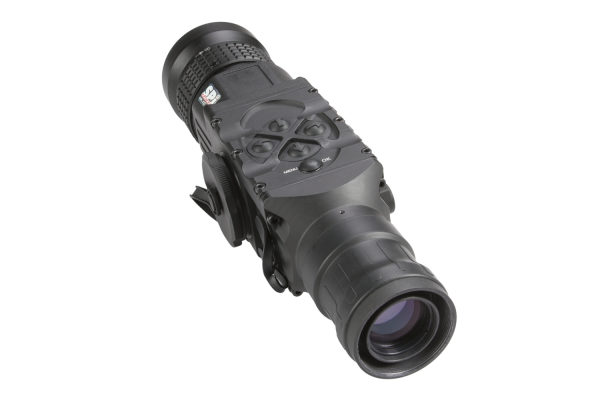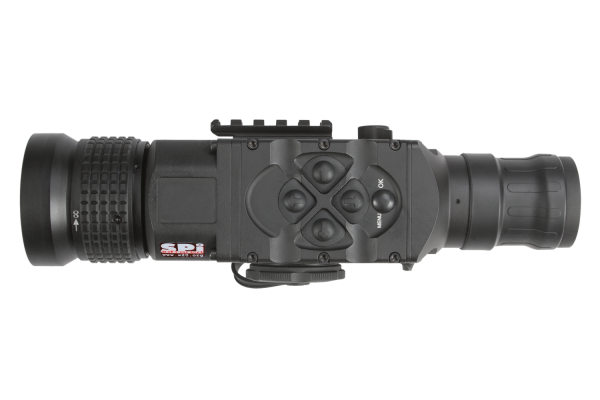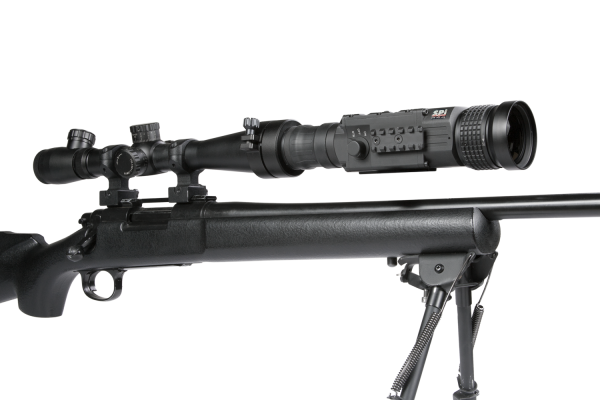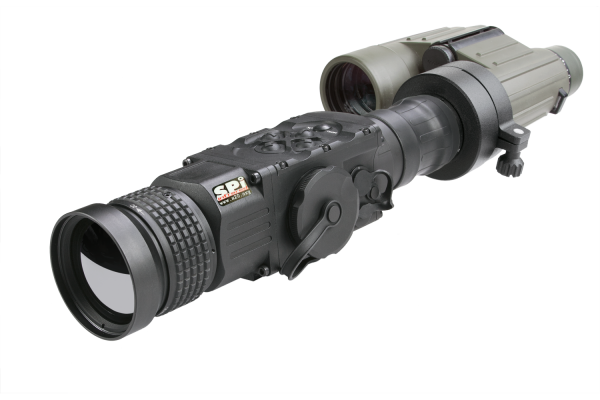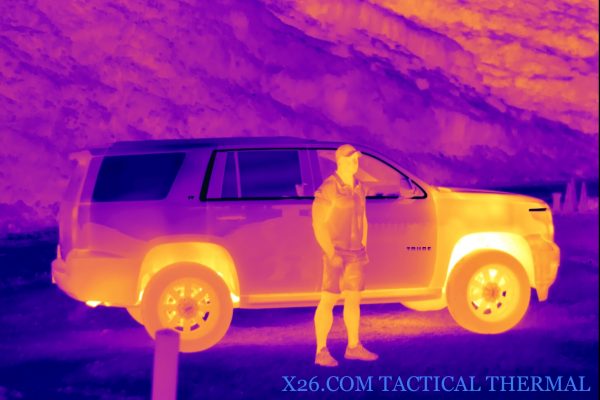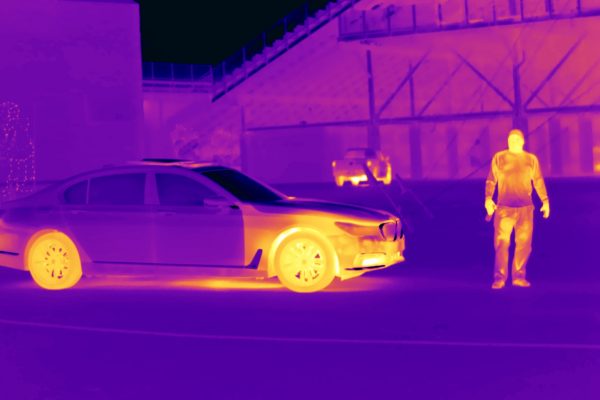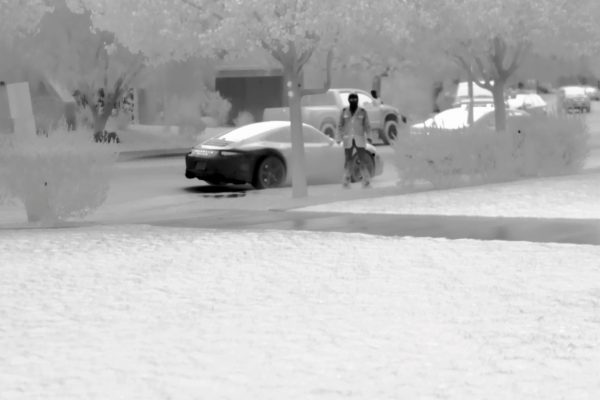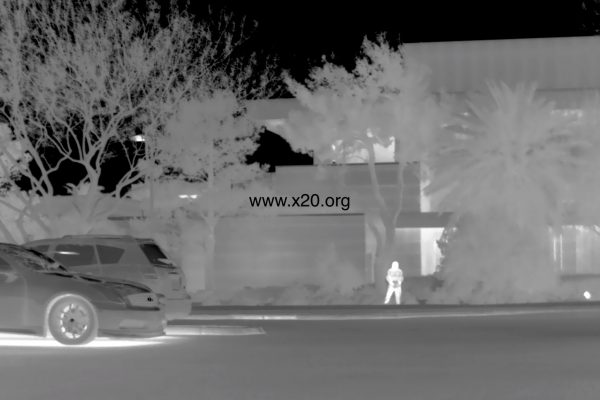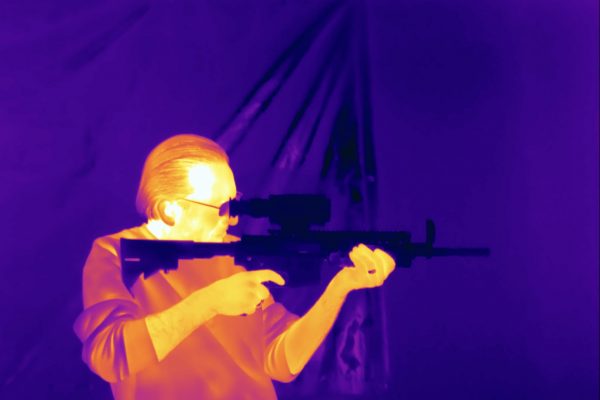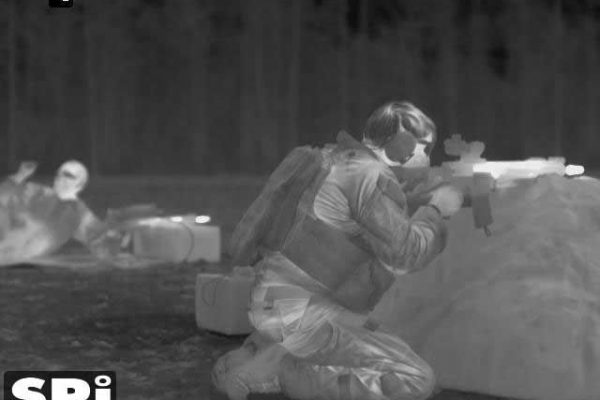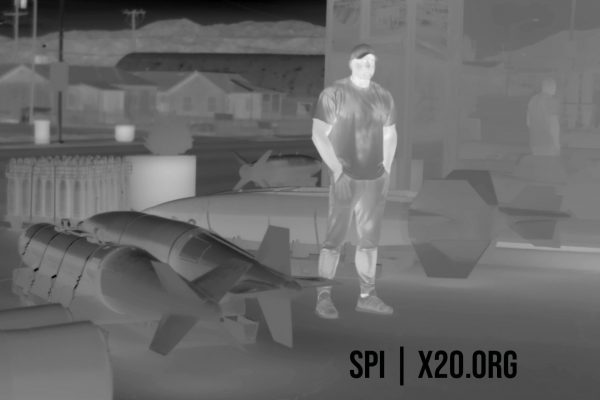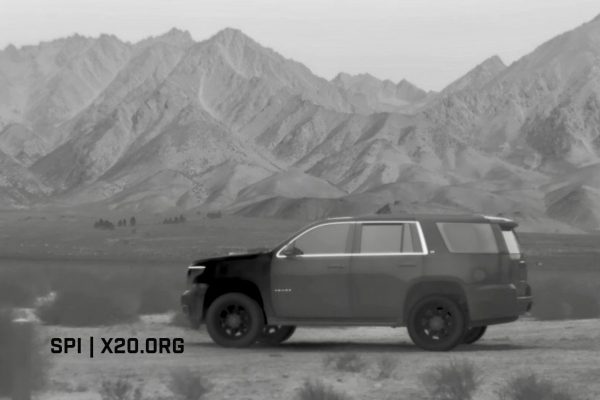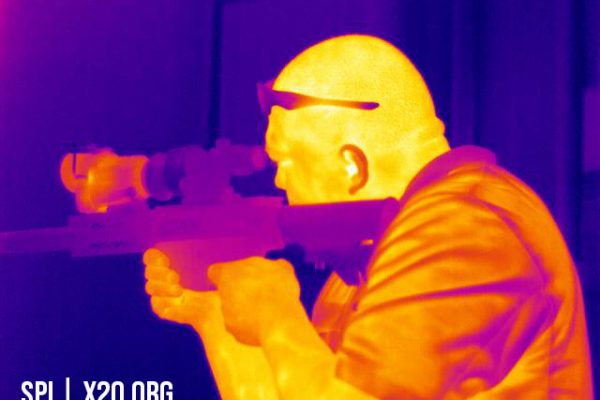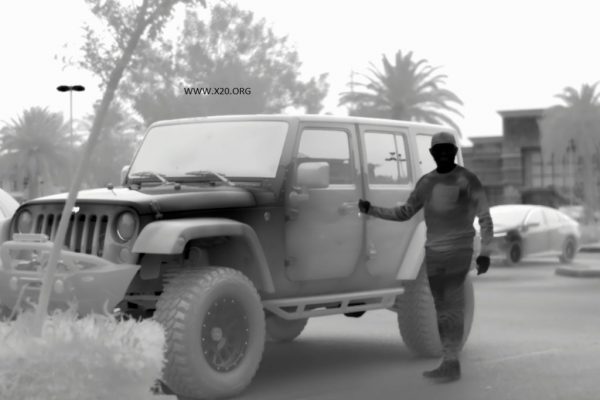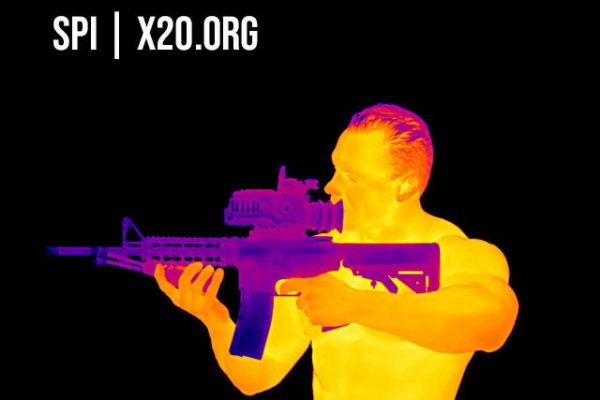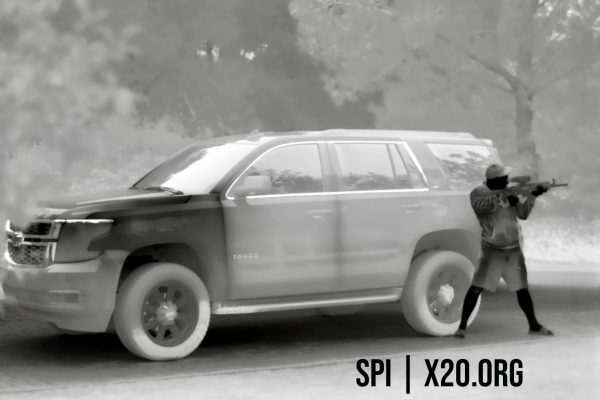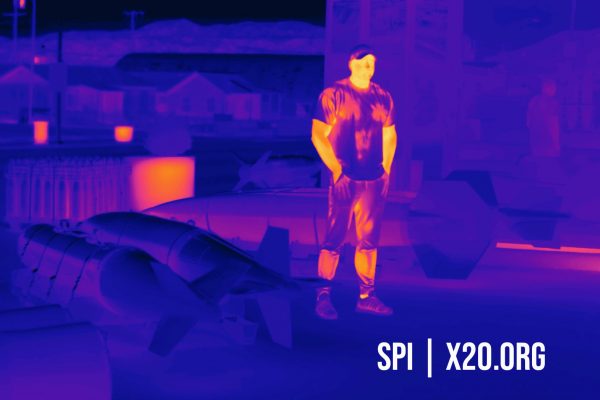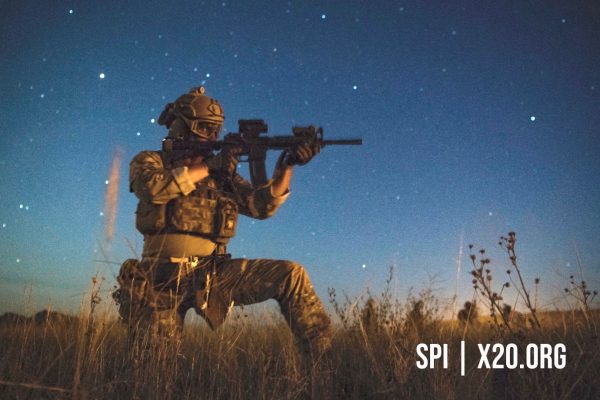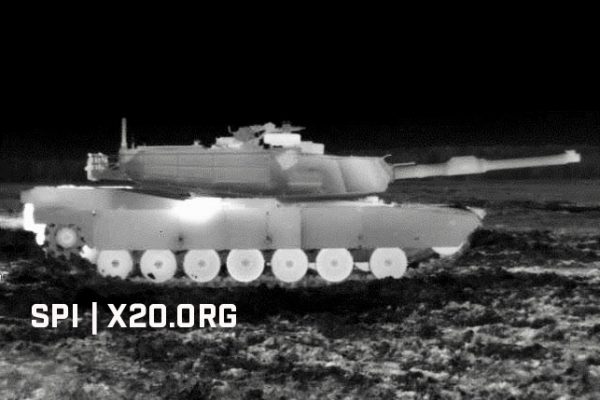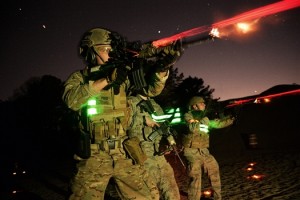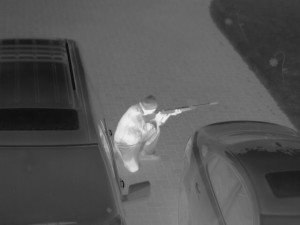Detector type: Hand select, high sensitivity Uncooled Focal Plane Array – USA
Refresh rate: 60 Hz
Resolution: Hand select 640 x 512 sensors with ultra sensitive, crisp imagery with TTM (Target Temperature Measurement)
FOV: 14.8 ° × 11.8° (H x V)
CHARACTERISTICS
PACKAGE INCLUDES
- Two Lithium CR123A batteries
- Loaded kit, All standard accessories, cables, user manual.
- Remote Control
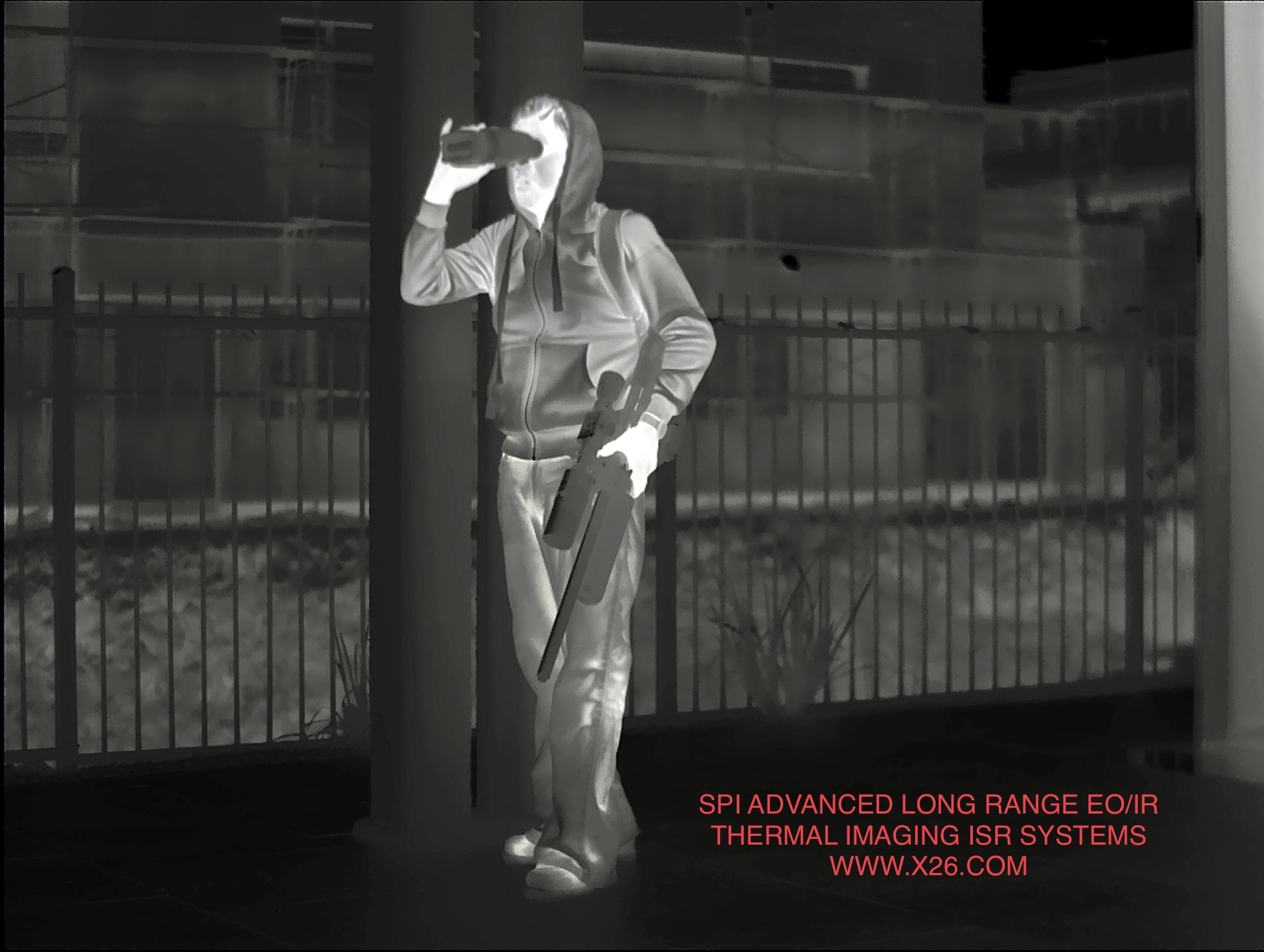
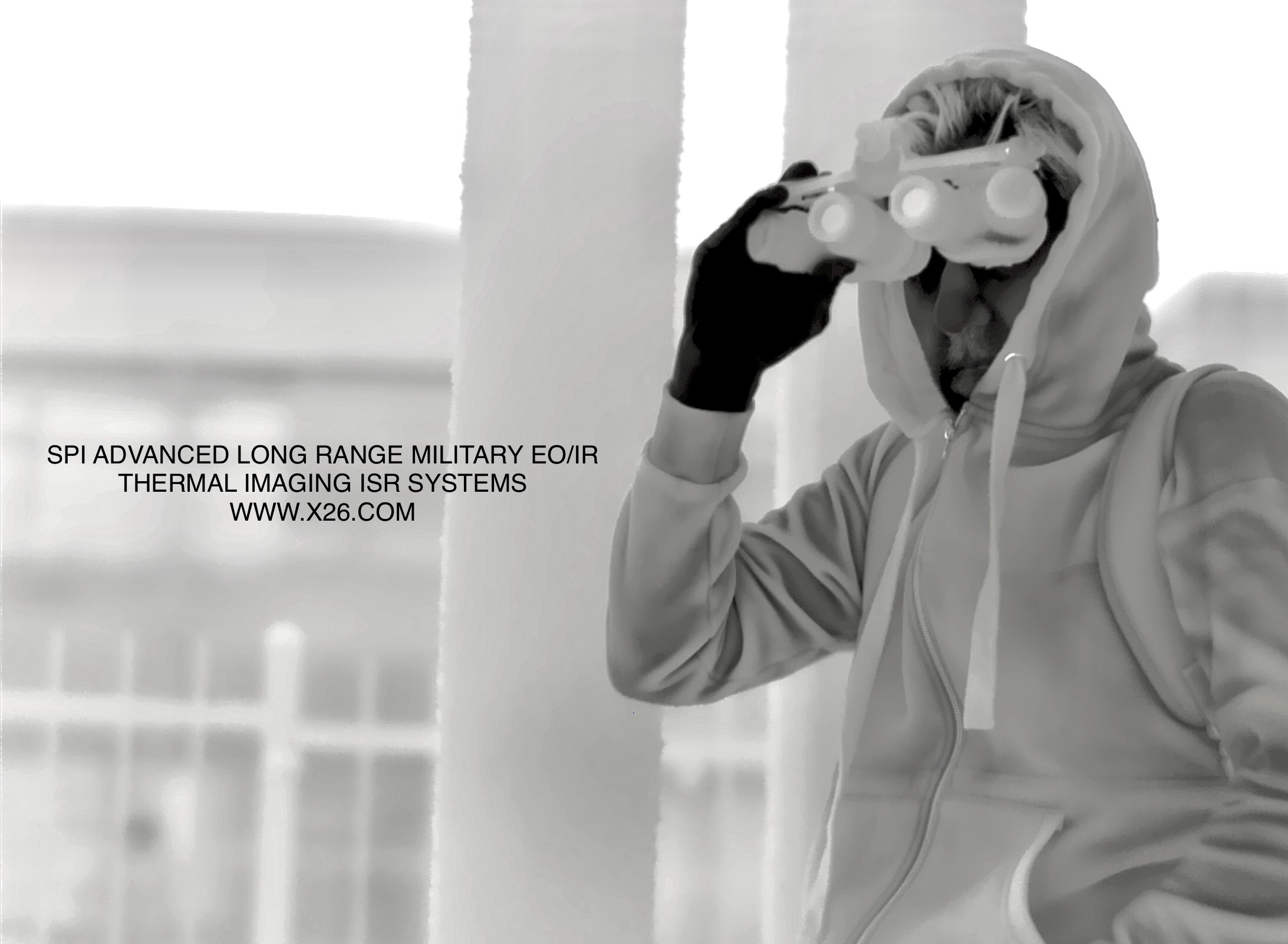
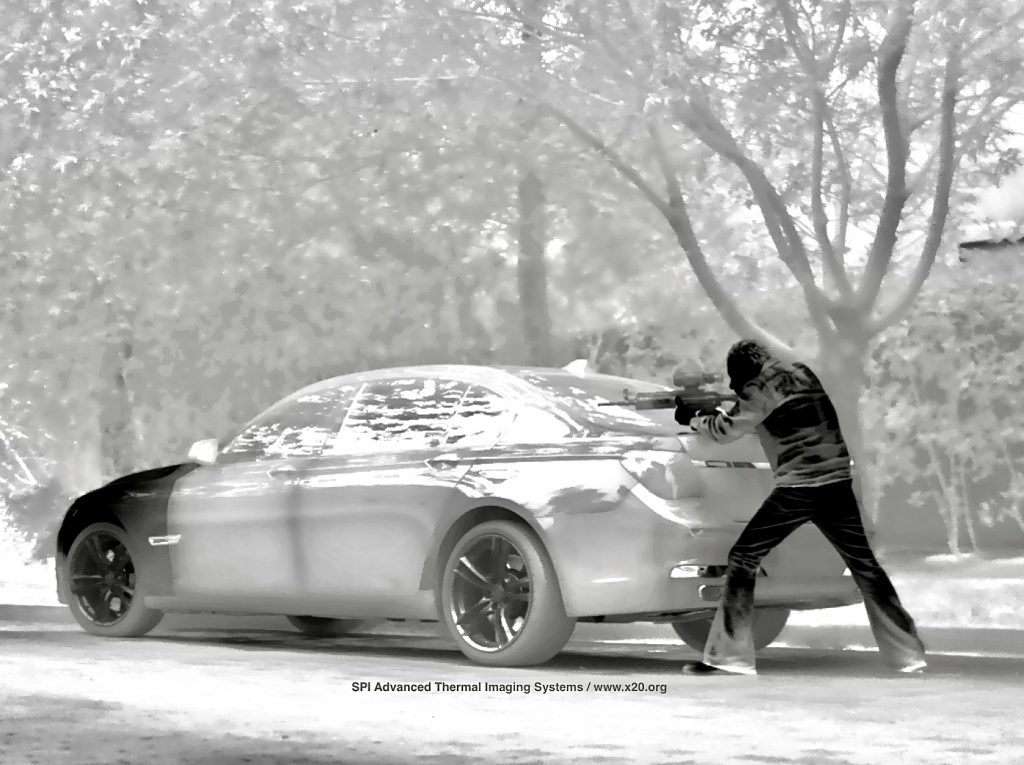
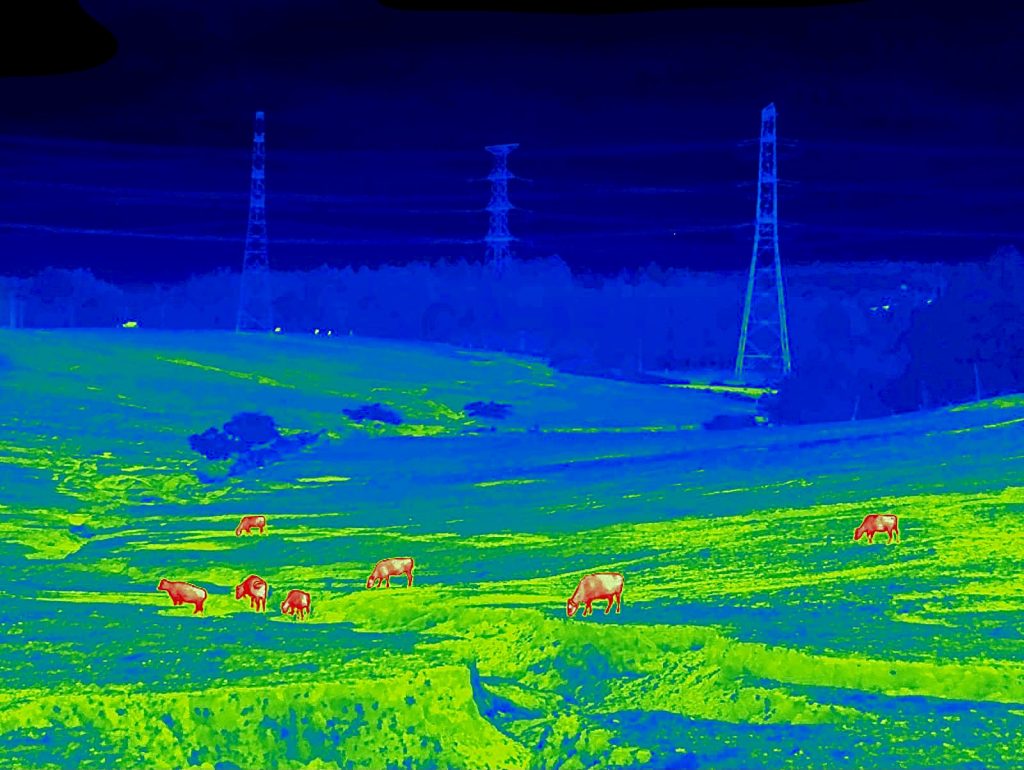
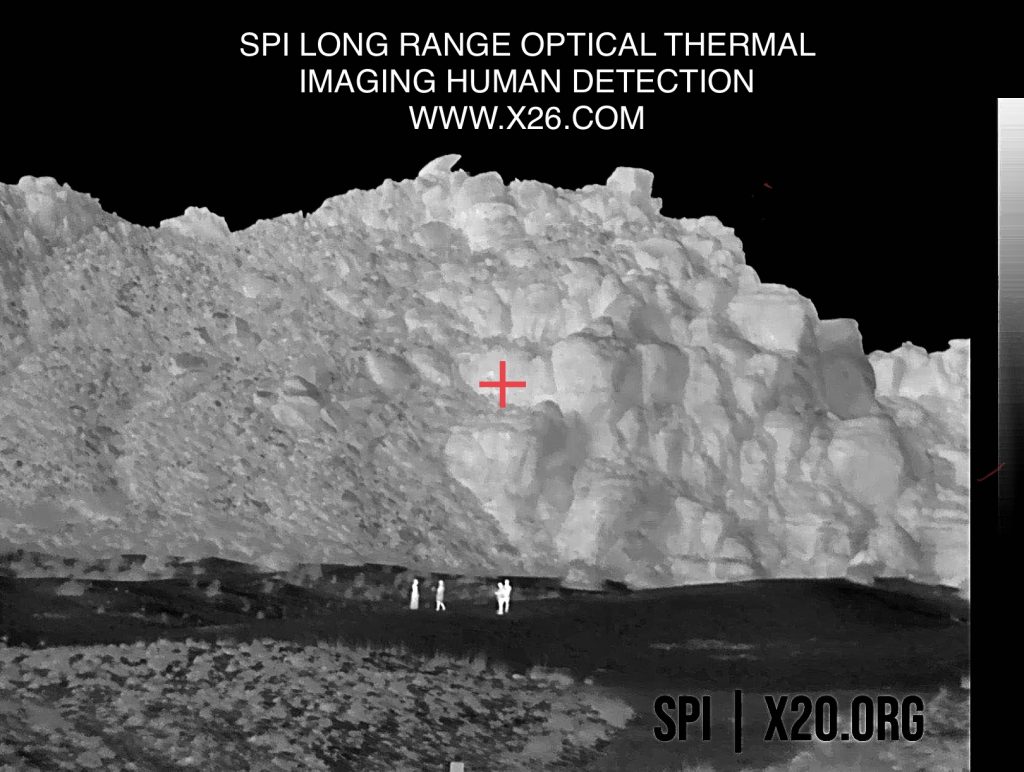
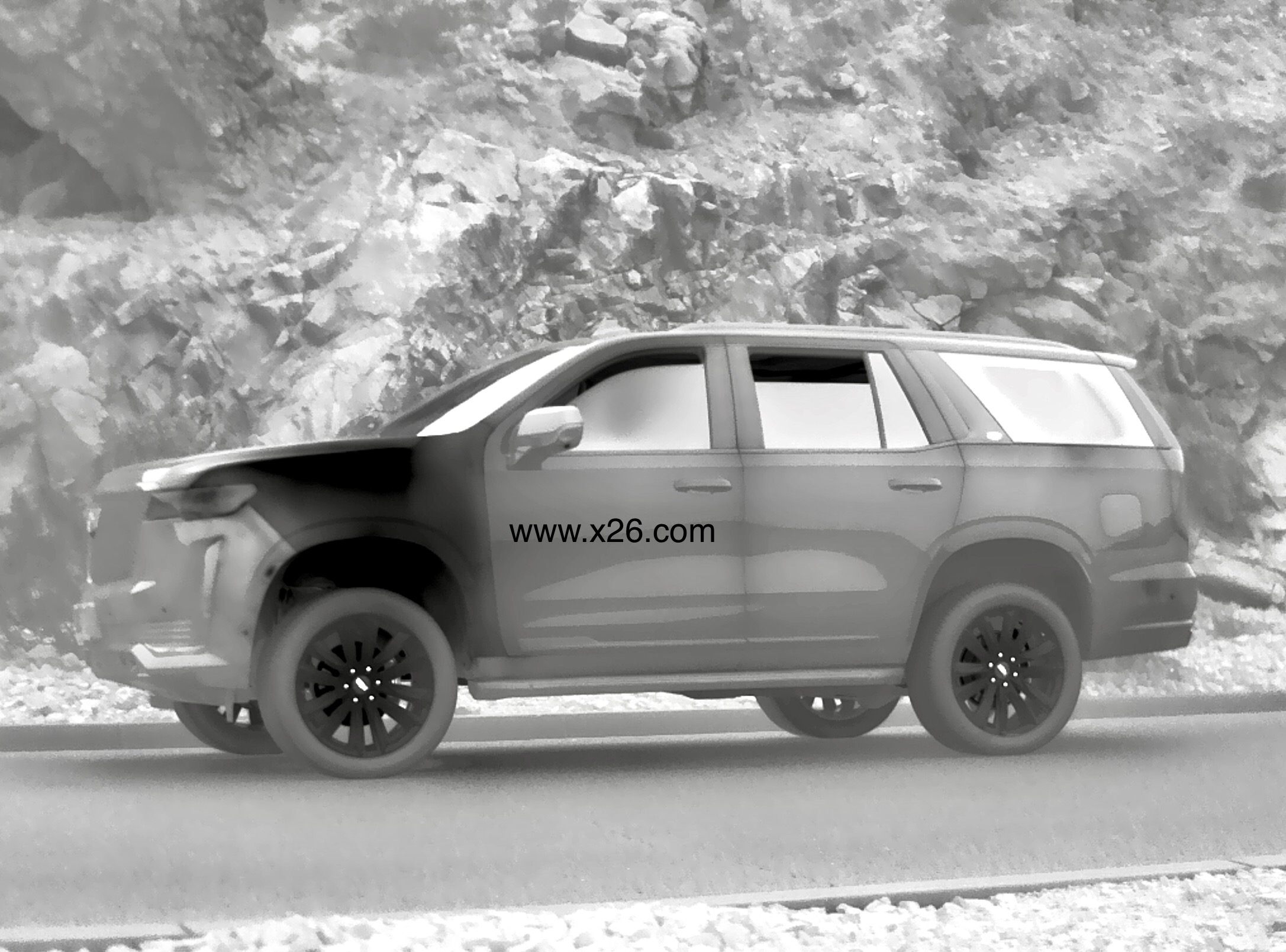
EXPORT RESTRICTIONS
Product shown herein is subject to US export regulations and may require a license prior to export. Any diversion contrary to US Government regulations is prohibited.
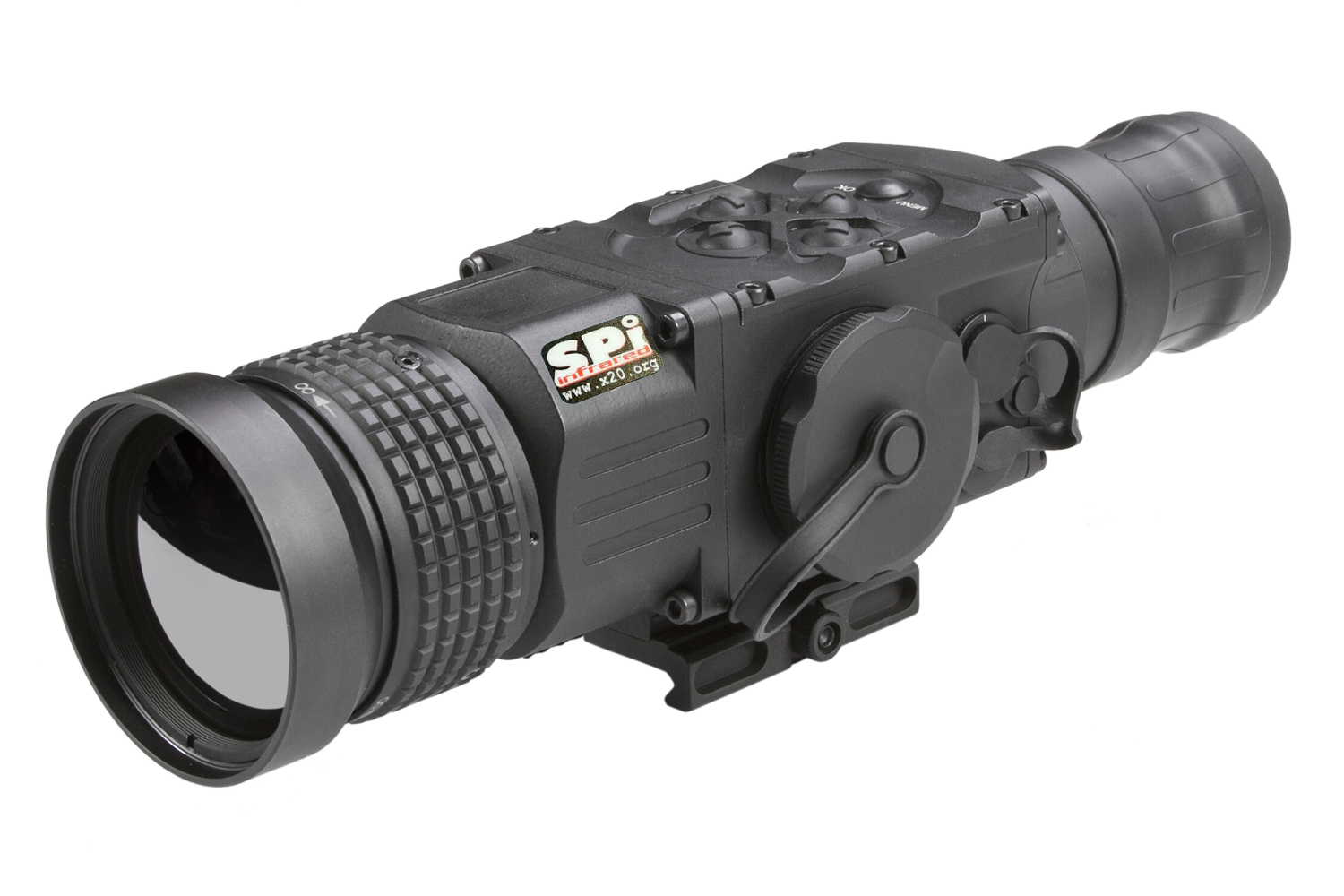
DESCRIPTION AND FEATURES
The SPI Dauber is a compact, all weather Ultra high performance, high sensitivity thermal IR imaging clip-on sniper sight that allows quick transformation of the day optics into thermal imaging device without any special skills. The system has real time TTM Target Temperature Measurement with multiple user modes for hunting, facial ID, snipe, Close Quarter and other environmental Target acquisitions settings which assist in discerning select targets of interest. The Dauber utilizes the best hand select LWIR FPA sensors coupled with rugged, hardened, coated Germanium optics. The Dauber can withstand serious recoil offering rock steady zero & can be easily attached in-line onto your dayscopes for Medium to long range use in day, dusk or in total darkness at night. Powered with two CR123 batteries the unit provides up to 5 hours of continuous work. An optional external battery pack (5V) with high-capacity is capable of increasing the total operation time to up to 44 hours. The Dauber can be also connected to an optional video recorder for shooting real time video or external Wi-Fi module for conjunction with smartphones.
- Quick conversion of daytime optics into thermal imaging scope
- Long range clip on thermal scope
- Real time numeric temperature measurement with bar and graph
- Outstanding sensitivity and image quality
- Rock steady accurate precision LWIR sight
- Used in day, twilight and at night
- Fully sealed, hardened, rugged all weather platform
- Crisp clear color OLED micro display with high clarity Quartz glass
- Mounts in front of any daytime scope, no re-zeroing is required
- Hand select ultra sensitive 17μm pitch thermal sensor
- Lightweight and robust design
- System can be used with binoculars, spotting scopes or monoculars.
- Multiple situational awareness modes
- Easy to operate, mount & learn IR sniper sight
- Manually adjustable objective lens
- Real-time video output / display
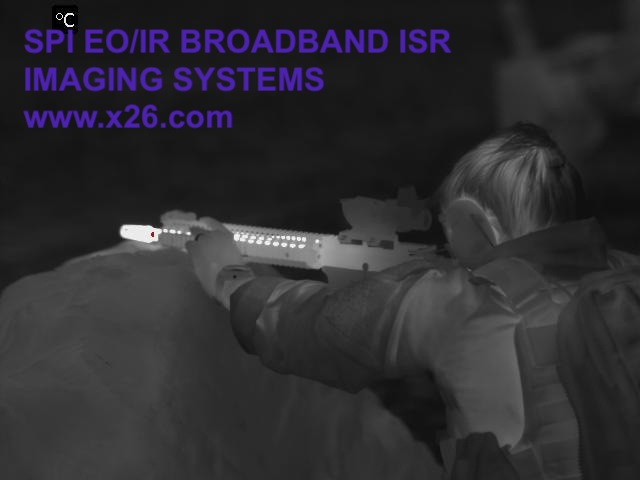
- Multiple color palettes
- Real time target temperature measurement Detection w/graph
- Military grade germanium optics
- Sensitivity to 1/10th of a degree
- Immune to solar/intense energy sources
- Top of the line thermal scope with outstanding detail enhancement
- Ultra rugged, hardened inside and out
- Precision accuracy Long range clip on thermal scope
- User selectable multiple real time target acquisition modes
- Wireless remote control
- Monochrome, reverse polarity and various color pallets
- Comprehensive, easy to maneuver menu interface
- Tactile direct man to machine buttonology
- Waterproof
- External Wi-Fi module
- Integral MIL-STD-1913 rails for optional accessories
- Powered by two standard CR123A batteries
- External power supply via micro USB
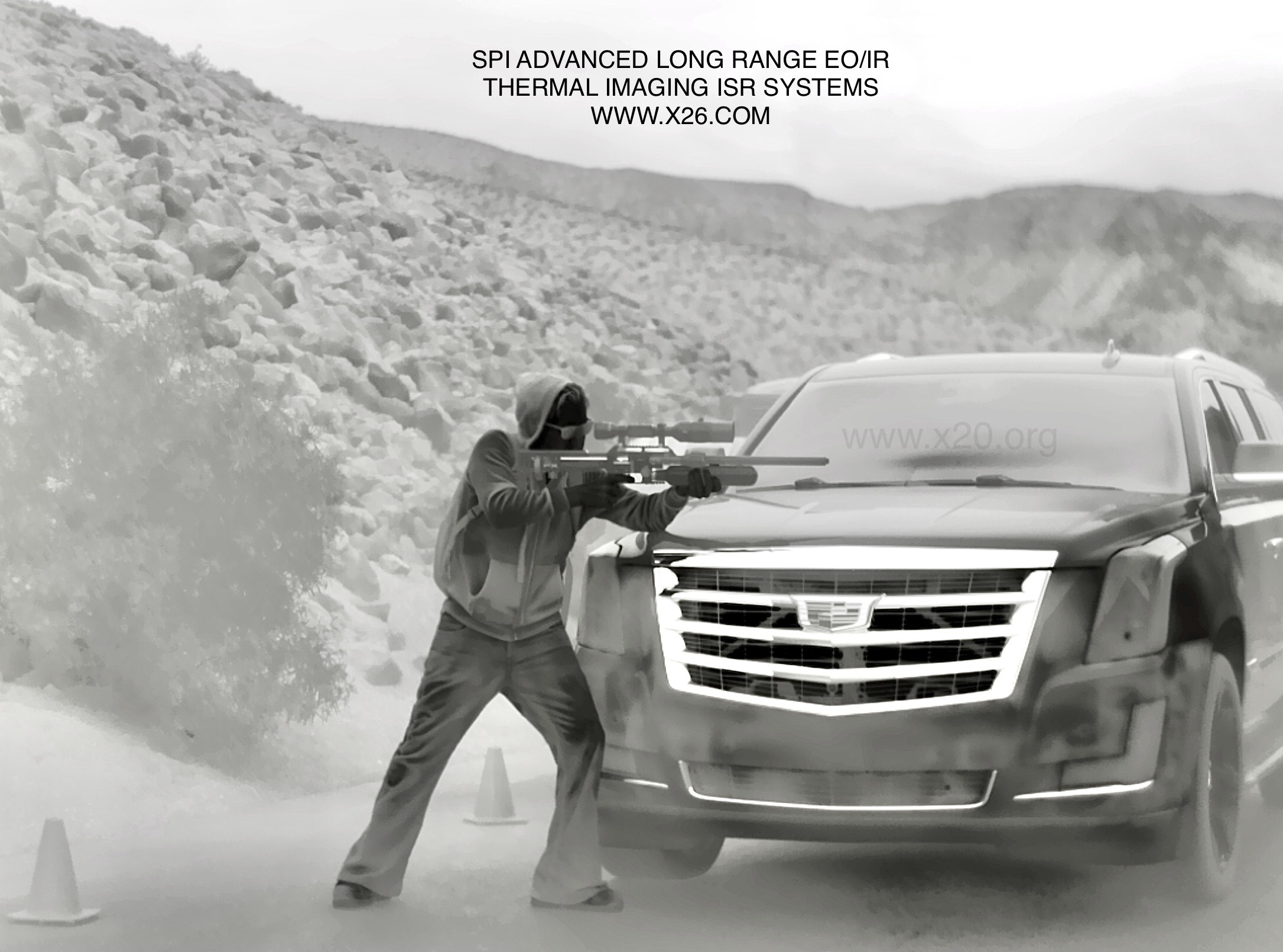
SPECIFICATIONS
| Storage temperature range | -40°C to +70°C (-40°F to +158°F) |
| Exit Pupil Diameter | 25mm |
| Remote control | Wireless (Activates/ Deactivates the scope in Standby Mode) |
| Imaging palettes/modes | Changeable Monochrome+Color / tactical / CQ / Sniper / hunting / Facial ID |
| Environment Rating | Waterproof |
| Detector type/Radiometry | Hand select ultra sensitive 17μm Uncooled Microbolometer, with TTM Radiometric temperature measurement up to 300 C |
| Refresh rate | 60 Hz |
| Resolution | 640 x 512 |
| Lens system | 50 mm; F/1 |
| Optical magnification | Variable |
| Field of view (H × X) | 14.8 ° × 11.8° (H x V) |
| Digital zoom | 1×, 2×,4 × and 8× |
| Diopter adjustment range | -5 to +5 dpt |
| Focusing range | 5 m to infinity |
| Eye relief | 60 mm |
| Display | 1280×1024 OLED / Quartz |
| Video output | PAL (768×574 pixels)/ NTSC (640×480 pixels) |
| Interfacing | S620 connector (Power In, Analog Video In/Out, Digital Video Recorder) |
| Battery Type | Two CR123 |
| Battery Life (Operating) | 5 hr |
| External power supply | External battery pack via micro-USB port |
| Power supply | 3.6~7.2V |
| Operating Temperature Range | -25°C to +55°C |
| Weight | 0.7 kg (1.5lbs) |
| Overall Dimensions | 208 x 71 x 81 mm (8.2 x 2.7 x 3.1 in) |
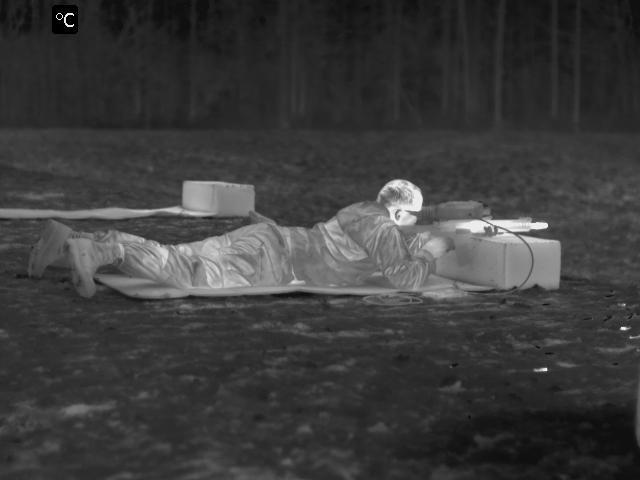
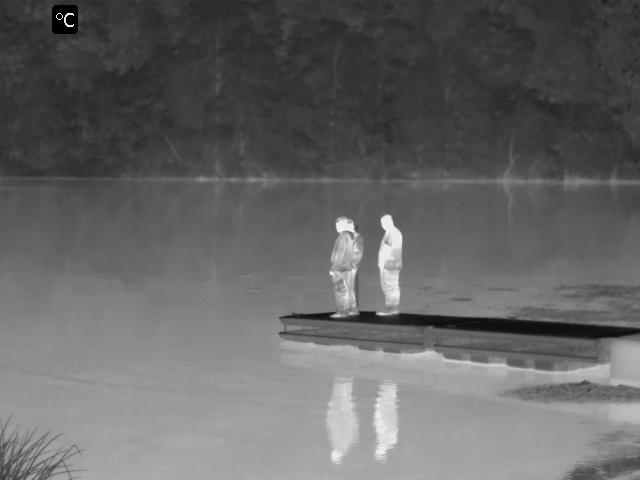
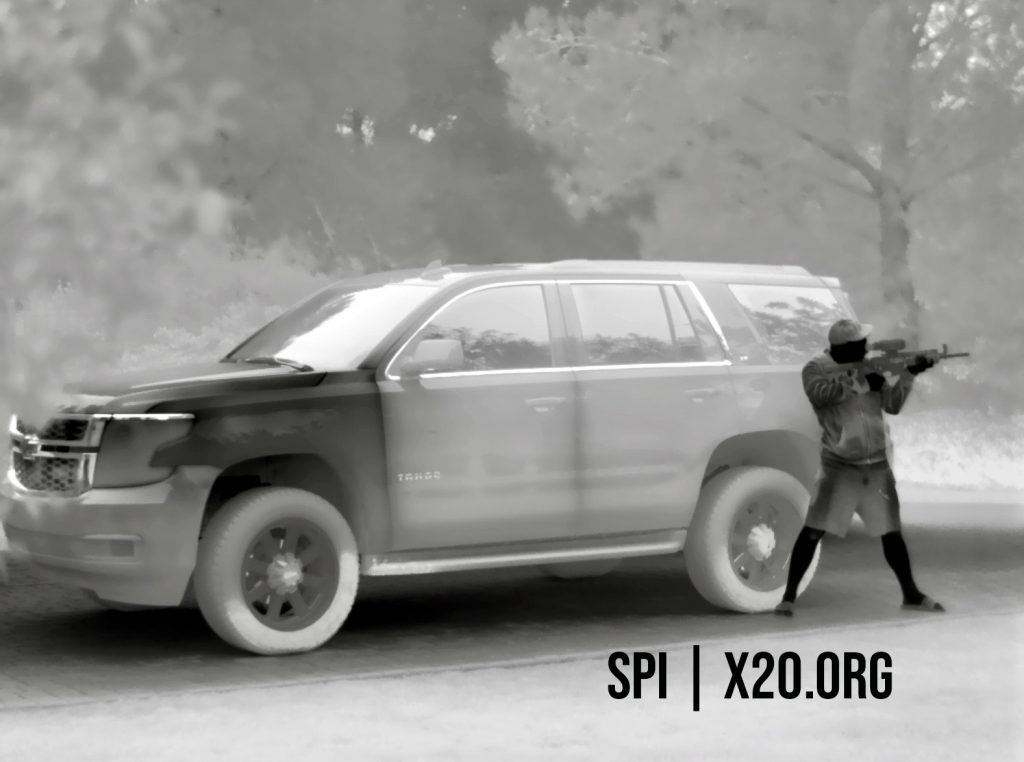
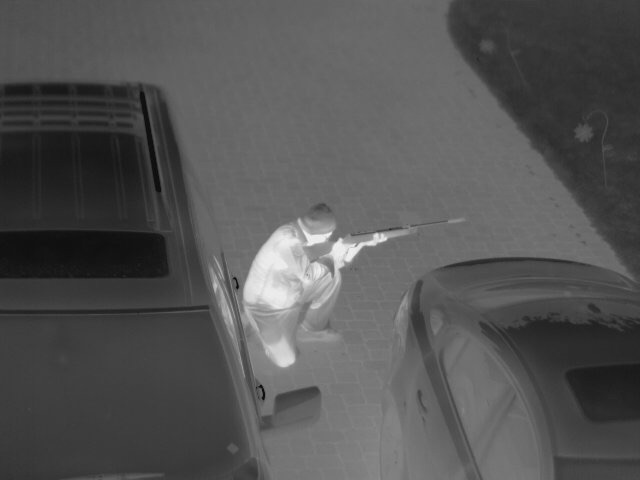
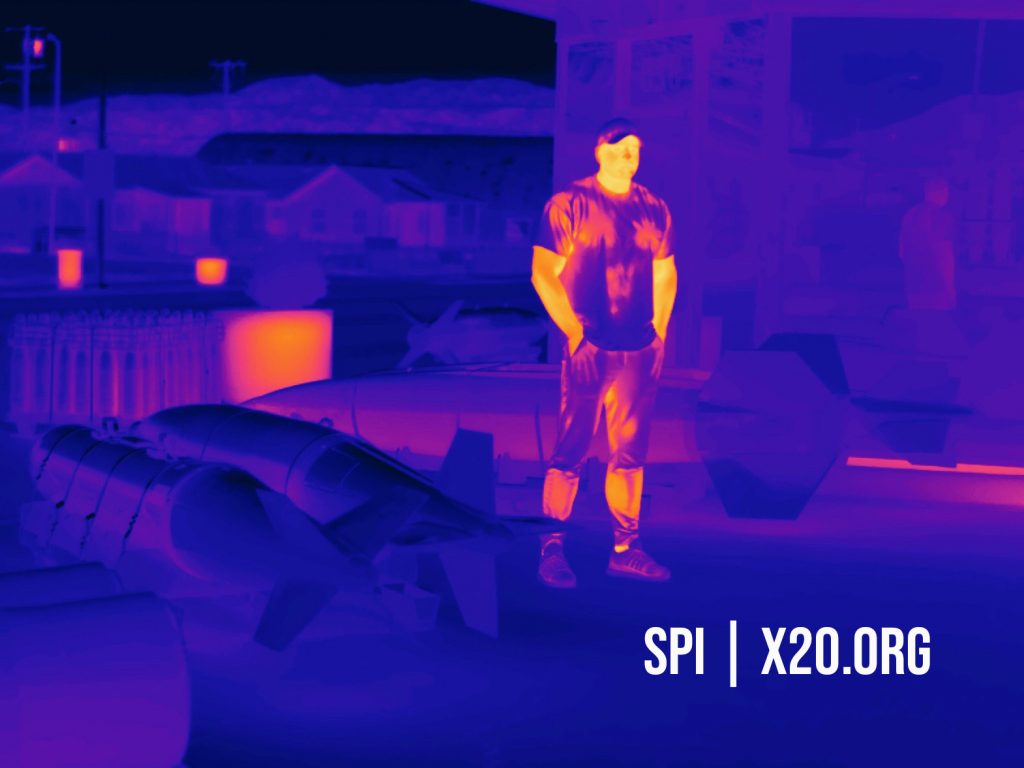
SPI THERMAL IMAGING FLIR RIFLE SCOPES/SIGHTS OVERVIEW
SPI thermal rifle scopes and sights use the latest technology in infrared imaging to reveal even slight temperature fluctuations and variations that occur in both man-made and natural objects. They use that information to generate an image even in near to total darkness. With multi-coated, Germanium lenses and compact, sturdy housing, our sights are water, dust, and sand-proof for unmatched reliability in uncharted territories, rough terrain, and extreme weather conditions. Our thermal weapon sights also offer:
- A fully adjustable electronic fine reticle for precision shooting
- Professional-grade lens materials and ergonomic design
- A digitally controlled boresight, which allows to change the position of your reticle without losing sight of the running center coordinates
- A locking quick-release mount
- Wireless remote control
- High sensitivity Long range clip on thermal scope
- Option to use either CR123A Lithium batteries or additional battery packs
Our Long range clip on thermal scope / sights are developed using the science of black body radiation, which demonstrates that objects with a temperature above absolute zero must emit infrared radiation. Radiation levels increase or decrease in response to changes or variations in an object’s temperature; thermal photography, or thermography, works by detecting the level of radiation that an object emits and translating it into an image. A thermal weapon sight, otherwise called a thermographic weapon sight or thermal imagery scope, combines a thermographic camera and an aiming reticle in one device that can be mounted on a variety of weapons. SPI’s superior thermal weapon sights are made from high-grade construction materials that are lightweight, weather-resistant, and tough.
We offer a wide range of field-tested, Military-grade thermal weapon sights. They feature:
- One Shot Zero with Freeze Function
- long range FLIR Thermalradar imaging scopes will mount to all rifles
- Digital boresight function
- Target Temperature Measurement
- Variable gain control
- 5 Zeroing profiles
- Powered by two CR123A Lithium batteries
- Stadiametric rangefinder
- High resolution 1024×768 display
- Long range clip on thermal scope
- Automatic or Manual (silent) Calibration
All SPI Long range clip on thermal scope are built to last, with high-quality construction and a host of features that allow our customers to feel safe, adaptable, and fully in control during covert operations, territory exploration, routine enforcement, and everything in between. Our thermal rifle scopes are water and fog-resistant, and always created for the most demanding tactical professionals. SPI customers know that our products offer superior quality and exceptional performance that’s low-maintenance and cost-effective.
SPI offers a wide selection of robust, shockproof all weather rugged dedicated rifle mounted thermal rifle scopes and flir weapon Sights. These systems are made to withstand high recoil and are the ultimate in night time target acquisition. Our long range thermal rifle scopes are imaging systems comprised of a thermal imaging detector with a thermal germanium lens. These components are hardened and built around a rugged scope housing. Multiple reticle crosshair choices as well as environmental image enhancement, digital detail correction algorithms and zoom factors make these systems an ideal solution for the professional game hunter and for law enforcement, military tactical target acquisition. Standard 1913 picatinny weaver rails come with ourLong range clip on thermal scope as we all as accessory mounting rails, shot counters, image storage and electronic zoom, our long range flir rifle scopes typically take AA or CR123 small COTS batteries. All of our systems are sealed to withstand rain, sleet, snow as well as tropical humid environments.
How does thermal infrared imaging or “FLIR” rifle scope technology work in a thermal weapon sight?
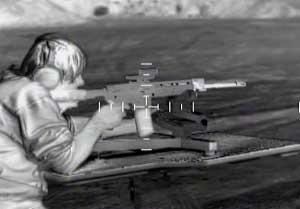 Utilizing superior thermal night vision technology coupled with uncooled FPA sight and scope FLIR technology, SPI’s Long range clip on thermal scope are a completely passive infrared weapon sighting system which allows users to identify the heat signatures of individuals or objects day or night and in rain, fog and smoke. No external flash infrared (IR illuminator) light source is required, and the unit may be used in complete darkness or broad daylight. When viewed through the scopes, heat-emitting objects such as humans and recently-operated vehicles stand out dramatically against their surroundings, defeating camouflage and other methods of visual concealment. Built to rugged standards, The FLIR thermal rifle scopes perform flawlessly. Our FLIR thermal weapon sights and IR infrared night vision thermal scopes are a shock and water-resistant sight that will withstand the forces generated by repeated recoil. The quick-detachable mount allows fast attachment to Mil-Std-1913 Picatinny rails and weapon receivers. Once sighted-in to a particular weapon, the sight may be interchanged with other SPi optical and electro-optical sights zeroed for the same weapon in a matter of seconds and without noticeable change in point of impact.
Utilizing superior thermal night vision technology coupled with uncooled FPA sight and scope FLIR technology, SPI’s Long range clip on thermal scope are a completely passive infrared weapon sighting system which allows users to identify the heat signatures of individuals or objects day or night and in rain, fog and smoke. No external flash infrared (IR illuminator) light source is required, and the unit may be used in complete darkness or broad daylight. When viewed through the scopes, heat-emitting objects such as humans and recently-operated vehicles stand out dramatically against their surroundings, defeating camouflage and other methods of visual concealment. Built to rugged standards, The FLIR thermal rifle scopes perform flawlessly. Our FLIR thermal weapon sights and IR infrared night vision thermal scopes are a shock and water-resistant sight that will withstand the forces generated by repeated recoil. The quick-detachable mount allows fast attachment to Mil-Std-1913 Picatinny rails and weapon receivers. Once sighted-in to a particular weapon, the sight may be interchanged with other SPi optical and electro-optical sights zeroed for the same weapon in a matter of seconds and without noticeable change in point of impact. 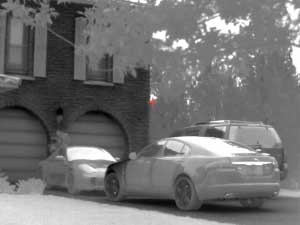 The electronic reticles come in many shapes, designs and sizes & allow precise targeting of hostile threats. SPI Long range clip on thermal scope operate on AA batteries or the COTS 3c CR123 lithium type and has auxiliary power ports for operation on AC electrical outlets or vehicle cigarette lighters. A vision video output port allows the image to be displayed on an external video monitor or recorded by flash video recorder. When used solely as an observation device, the unit may be operated hand-held or tripod mounted. Weighing less than three pounds, the FLIR thermal camera is a compact yet powerful tool for Security, law enforcement, EOD, battle lab, arsenal, US government labs & US Military professionals.
The electronic reticles come in many shapes, designs and sizes & allow precise targeting of hostile threats. SPI Long range clip on thermal scope operate on AA batteries or the COTS 3c CR123 lithium type and has auxiliary power ports for operation on AC electrical outlets or vehicle cigarette lighters. A vision video output port allows the image to be displayed on an external video monitor or recorded by flash video recorder. When used solely as an observation device, the unit may be operated hand-held or tripod mounted. Weighing less than three pounds, the FLIR thermal camera is a compact yet powerful tool for Security, law enforcement, EOD, battle lab, arsenal, US government labs & US Military professionals.
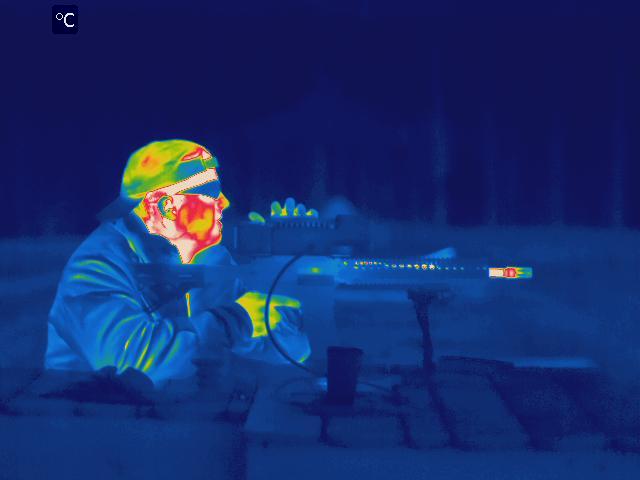
There are two common types of thermal FLIR imaging devices: Uncooled (LWIR Long wave infrared)– This is the most common type of thermal-imaging device. The infrared-detector elements are contained in a unit that operates at room temperature. This type of system is completely quiet, activates immediately and has the battery built right in. Cryogenically cooled – More expensive and more susceptible to damage from rugged use, these systems have the elements sealed inside a container that cools them to below 32 F (zero C). The advantage of such a system is the incredible resolution and sensitivity that result from cooling the elements. Cryogenically-cooled systems can “see” a difference as small as 0.2 F (0.1 C) from more than 1,000 ft (300 m) away, which is enough to tell if a person is holding a gun at that distance! While thermal imaging is great for detecting people or working in near-absolute darkness, most night-vision equipment uses image- enhancement technology, which you will learn about in the next section. Image Enhancement: Image-enhancement technology is what most people think of when you talk about night vision. In fact, image-enhancement systems are normally called night-vision devices (NVDs). NVDs rely on a special tube, called an image-intensifier tube, to collect and amplify infrared and visible light. The image-intensifier tube changes photons to electrons and back again. A conventional lens, called the objective lens, captures ambient light and some near-infrared light.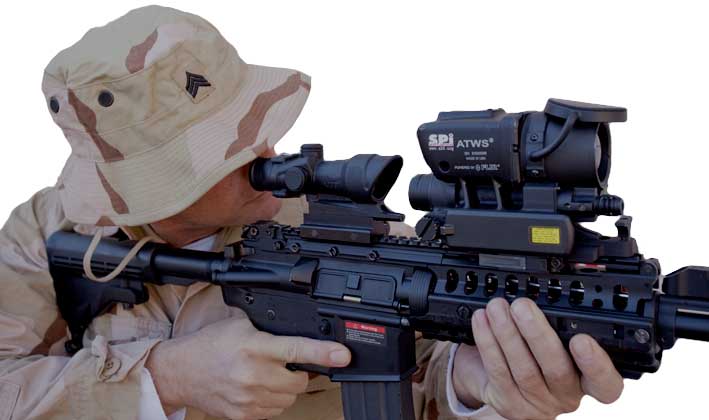 The gathered light is sent to the image-intensifier tube. In most NVDs, the power supply for the image-intensifier tube receives power from two N-Cell or two “AA” batteries. The tube outputs a high voltage, about 5,000 volts, to the image-tube components. The image-intensifier tube has a photo cathode, which is used to convert the photons of light energy into electrons. As the electrons pass through the tube, similar electrons are released from atoms in the tube, multiplying the original number of electrons by a factor of thousands through the use of a microchannel plate (MCP) in the tube. An MCP is a tiny, glass disc that has millions of microscopic holes (microchannels) in it, made using fiber-optic technology. The MCP is contained in a vacuum and has metal electrodes on either side of the disc. Each channel is about 45 times longer than it is wide, and it works as an electron multiplier. When the electrons from the photo cathode hit the first electrode of the MCP, they are accelerated into the glass microchannels by the 5,000-V bursts being sent between the electrode pair. As electrons pass through the microchannels, they cause thousands of other electrons to be released in each channel using a process called cascaded secondary emission. Basically, the original electrons collide with the side of the channel, exciting atoms and causing other electrons to be released. These new electrons also collide with other atoms, creating a chain reaction that results in thousands of electrons leaving the channel where only a few entered. An interesting fact is that the microchannels in the MCP are created at a slight angle (about a 5-degree to 8-degree bias) to encourage electron collisions and reduce both ion and direct-light feedback from the phosphors on the output side.
The gathered light is sent to the image-intensifier tube. In most NVDs, the power supply for the image-intensifier tube receives power from two N-Cell or two “AA” batteries. The tube outputs a high voltage, about 5,000 volts, to the image-tube components. The image-intensifier tube has a photo cathode, which is used to convert the photons of light energy into electrons. As the electrons pass through the tube, similar electrons are released from atoms in the tube, multiplying the original number of electrons by a factor of thousands through the use of a microchannel plate (MCP) in the tube. An MCP is a tiny, glass disc that has millions of microscopic holes (microchannels) in it, made using fiber-optic technology. The MCP is contained in a vacuum and has metal electrodes on either side of the disc. Each channel is about 45 times longer than it is wide, and it works as an electron multiplier. When the electrons from the photo cathode hit the first electrode of the MCP, they are accelerated into the glass microchannels by the 5,000-V bursts being sent between the electrode pair. As electrons pass through the microchannels, they cause thousands of other electrons to be released in each channel using a process called cascaded secondary emission. Basically, the original electrons collide with the side of the channel, exciting atoms and causing other electrons to be released. These new electrons also collide with other atoms, creating a chain reaction that results in thousands of electrons leaving the channel where only a few entered. An interesting fact is that the microchannels in the MCP are created at a slight angle (about a 5-degree to 8-degree bias) to encourage electron collisions and reduce both ion and direct-light feedback from the phosphors on the output side.
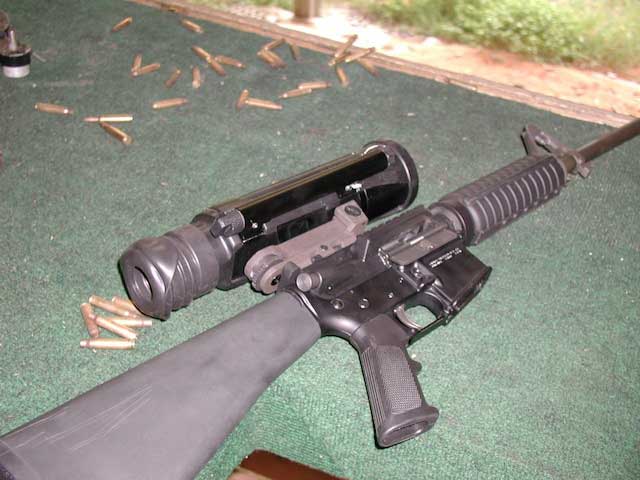 Night-vision images are known for their eerie green tint. At the end of the image-intensifier tube, the electrons hit a screen coated with phosphors. These electrons maintain their position in relation to the channel they passed through, which provides a perfect image since the electrons stay in the same alignment as the original photons. The energy of the electrons causes the phosphors to reach an excited state and release photons. These phosphors create the green image on the screen that has come to characterize night vision. The green phosphor image is viewed through another lens, called the ocular lens, which allows you to magnify and focus the image. The NVD may be connected to an electronic display, such as a monitor, or the image may be viewed directly through the ocular lens. NVDs have been around for more than 40 years. They are categorized by generation. Each substantial change in NVD technology establishes a new generation. Generation 0 – The original night-vision system created by the United States Army and used in World War II and the Korean War, these NVDs use active infrared. This means that a projection unit, called an IR Illuminator, is attached to the NVD.
Night-vision images are known for their eerie green tint. At the end of the image-intensifier tube, the electrons hit a screen coated with phosphors. These electrons maintain their position in relation to the channel they passed through, which provides a perfect image since the electrons stay in the same alignment as the original photons. The energy of the electrons causes the phosphors to reach an excited state and release photons. These phosphors create the green image on the screen that has come to characterize night vision. The green phosphor image is viewed through another lens, called the ocular lens, which allows you to magnify and focus the image. The NVD may be connected to an electronic display, such as a monitor, or the image may be viewed directly through the ocular lens. NVDs have been around for more than 40 years. They are categorized by generation. Each substantial change in NVD technology establishes a new generation. Generation 0 – The original night-vision system created by the United States Army and used in World War II and the Korean War, these NVDs use active infrared. This means that a projection unit, called an IR Illuminator, is attached to the NVD.

The unit projects a beam of near-infrared light, similar to the beam of a normal flashlight. Invisible to the naked eye, this beam reflects off objects and bounces back to the lens of the NVD. These systems use an anode in conjunction with the cathode to accelerate the electrons. The problem with that approach is that the acceleration of the electrons distorts the image and greatly decreases the life of the tube. Another major problem with this technology in its original military use was that it was quickly duplicated by hostile nations, which allowed enemy soldiers to use their own NVDs to see the infrared beam projected by the device. Generation 1 – The next generation of NVDs moved away from active infrared, using passive infrared instead. Once dubbed Starlight by the U.S. Army, these NVDs use ambient light provided by the moon and stars to augment the normal amounts of reflected infrared in the environment. This means that they did not require a source of projected infrared light. This also means that they do not work very well on cloudy or moonless nights. Generation-1 NVDs use the same image- intensifier tube technology as Generation 0, with both cathode and anode, so image distortion and short tube life are still a problem. Generation 2 – Major improvements in image-intensifier tubes resulted in Generation-2 NVDs. They offer improved resolution and performance over Generation-1 devices, and are considerably more reliable. The biggest gain in Generation 2 is the ability to see in extremely low light conditions, such as a moonless night. This increased sensitivity is due to the addition of the microchannel plate to the image-intensifier tube. Since the MCP actually increases the number of electrons instead of just accelerating the original ones, the images are significantly less distorted and brighter than earlier-generation NVDs. Generation 3 – The latest and greatest NVD technology, Generation 3 is currently used by the U.S. military. While there are no substantial changes in the underlying technology from Generation 2, these NVDs have even ![]() better resolution and sensitivity. This is because the photo cathode is made using gallium arsenide, which is very efficient at converting photons to electrons. Additionally, the MCP is coated with an ion barrier, which dramatically increases the life of the tube. Generation-3 NVDs are considered so state-of-the-art that they cannot be exported from the United States without a license from the U.S. Department of State that details the recipient and the purpose it will be used for. Many of the so-called “bargain” night-vision scopes use Generation- 0 or Generation-1 technology, and may be disappointing if you expect the sensitivity of the devices used by professionals. Generation-2 and Generation-3 NVDs are typically very expensive to purchase, but they will last a lifetime if properly cared for. Also, any NVD can benefit from the use of an IR Illuminator in very dark areas where there is almost no ambient light to collect.
better resolution and sensitivity. This is because the photo cathode is made using gallium arsenide, which is very efficient at converting photons to electrons. Additionally, the MCP is coated with an ion barrier, which dramatically increases the life of the tube. Generation-3 NVDs are considered so state-of-the-art that they cannot be exported from the United States without a license from the U.S. Department of State that details the recipient and the purpose it will be used for. Many of the so-called “bargain” night-vision scopes use Generation- 0 or Generation-1 technology, and may be disappointing if you expect the sensitivity of the devices used by professionals. Generation-2 and Generation-3 NVDs are typically very expensive to purchase, but they will last a lifetime if properly cared for. Also, any NVD can benefit from the use of an IR Illuminator in very dark areas where there is almost no ambient light to collect.
A cool thing to note is that every single image-intensifier tube is put through rigorous tests to see if it meets the requirements set forth by the military. T Scopes – Normally handheld or mounted on a weapon, scopes are monocular (one eye-piece). Since scopes are are handheld, not worn like goggles, they are good for when you want to get a better look at a specific object and then return to normal viewing conditions. Goggles – While goggles can be handheld, they are most often worn on the head. Goggles are binocular (two eye- pieces) and may have a single lens or stereo lens, depending on the model. Goggles are excellent for constant viewing, such as moving around in a dark building. The original purpose of night vision was to locate enemy targets at night. It is still used extensively by the military for that purpose, as well as for navigation, surveillance and targeting. Police and security often use both thermal-imaging and image-enhancement technology, particularly for surveillance. Hunters and nature enthusiasts use NVDs to maneuver through the woods at night. Detectives and private investigators use night vision to watch people they are assigned to track.
Many businesses have permanently- mounted cameras equipped with night vision to monitor the surroundings. A really amazing ability of thermal-imaging is that it reveals whether an area has been disturbed — it can show that the ground has been dug up to bury something, even if there is no obvious sign to the naked eye. Law enforcement has used this to discover items that have been hidden by criminals, including money, drugs and bodies. Also, recent changes to areas such as walls can be seen using thermal imaging, which has provided important clues in several cases. Many people are beginning to discover the unique world that can be found after darkness falls. If you’re out camping or hunting a lot, chances are that night-vision devices can be useful to you — just be sure to get the right type for your needs.
Click here to read a recent article about thermal
rifle scopes regulations for hunting


